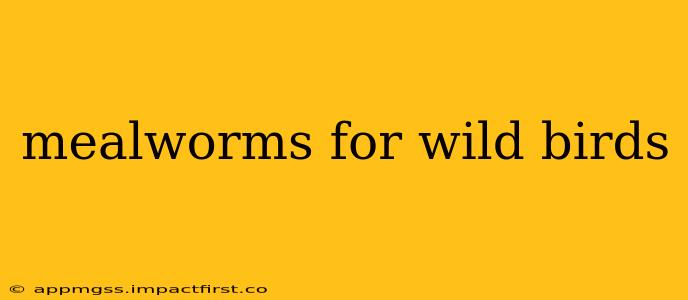Feeding wild birds is a rewarding hobby, connecting us with nature and providing essential support, especially during harsh weather or breeding seasons. Mealworms, the larval form of the darkling beetle, are a popular choice for supplemental feeding, but are they truly beneficial for our feathered friends? This comprehensive guide explores the advantages, disadvantages, and best practices surrounding the use of mealworms for wild birds.
Are Mealworms Good for Wild Birds?
Mealworms are a good source of protein and fat, vital for energy and growth, particularly beneficial for fledglings and during colder months when natural food sources are scarce. They offer a nutritious boost, supplementing the birds' diet with essential nutrients. However, it's crucial to remember that mealworms shouldn't replace a varied natural diet. Over-reliance on mealworms can lead to nutritional imbalances and potentially harm birds in the long run.
What are the Benefits of Feeding Mealworms to Wild Birds?
- High Protein Content: Mealworms are packed with protein, essential for muscle development, feather growth, and overall health. This is especially crucial for growing chicks.
- Rich in Fat: The fat content provides energy, vital for survival, especially in cold weather or during migration.
- Attractive Food Source: Their wriggling movement and high nutritional value make them attractive to many bird species.
- Easy to Store and Feed: Dried or live mealworms are readily available and relatively easy to store and dispense.
What are the Drawbacks of Feeding Mealworms to Wild Birds?
- Nutritional Imbalance: A diet consisting solely of mealworms lacks essential vitamins and minerals found in a diverse natural diet.
- Chitin Content: The exoskeleton of mealworms contains chitin, which can be difficult for some birds to digest in large quantities.
- Potential for Obesity: Overfeeding mealworms can lead to obesity, impacting birds' ability to fly and increasing susceptibility to disease.
- Dependence and Reduced Foraging: Easy access to high-energy food can reduce birds' natural foraging behavior, impacting their survival skills.
- Attracting Pests: Improper disposal of uneaten mealworms can attract rodents and other unwanted pests to your garden.
What Kind of Mealworms are Best for Wild Birds?
Live mealworms are generally preferred by birds as they move and mimic natural prey. However, dried mealworms offer a convenient alternative for storage and feeding, though some birds might be less enthusiastic about them. Avoid flavored or coated mealworms, as these additives can be harmful to birds.
How Often Should I Feed Wild Birds Mealworms?
Mealworms should be offered as a supplementary food, not a staple. A small amount a few times a week is sufficient. Observe the birds' behavior and adjust the amount accordingly. Avoid overfeeding, as this can have negative consequences.
What Birds Eat Mealworms?
Many bird species enjoy mealworms, including robins, bluebirds, wrens, sparrows, and starlings. However, the diet of each species varies, and mealworms should only be offered as part of a varied diet.
Can I Feed Mealworms to Baby Birds?
While mealworms can be a helpful supplemental food source for fledglings, ensuring a balanced diet rich in insects and other natural food sources is critical for their healthy development. Always prioritize providing a varied diet, and consult a wildlife rehabilitation expert if you find injured or orphaned baby birds.
Are there Alternatives to Mealworms for Feeding Wild Birds?
A variety of foods can supplement a wild bird's diet. Suet, nuts, seeds, fruits, and other insects provide a well-rounded nutritional balance. Providing a diverse food source ensures the birds receive a complete range of nutrients.
By understanding the benefits and drawbacks of using mealworms, bird enthusiasts can provide supplemental nutrition responsibly and contribute to the health and well-being of their local bird populations. Remember moderation and variety are key to supporting a thriving avian ecosystem.
